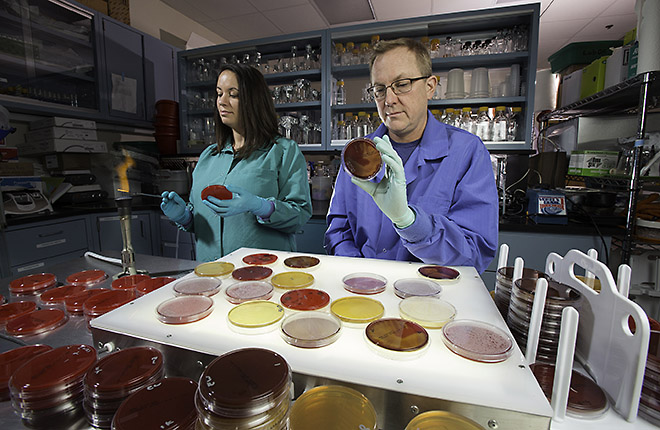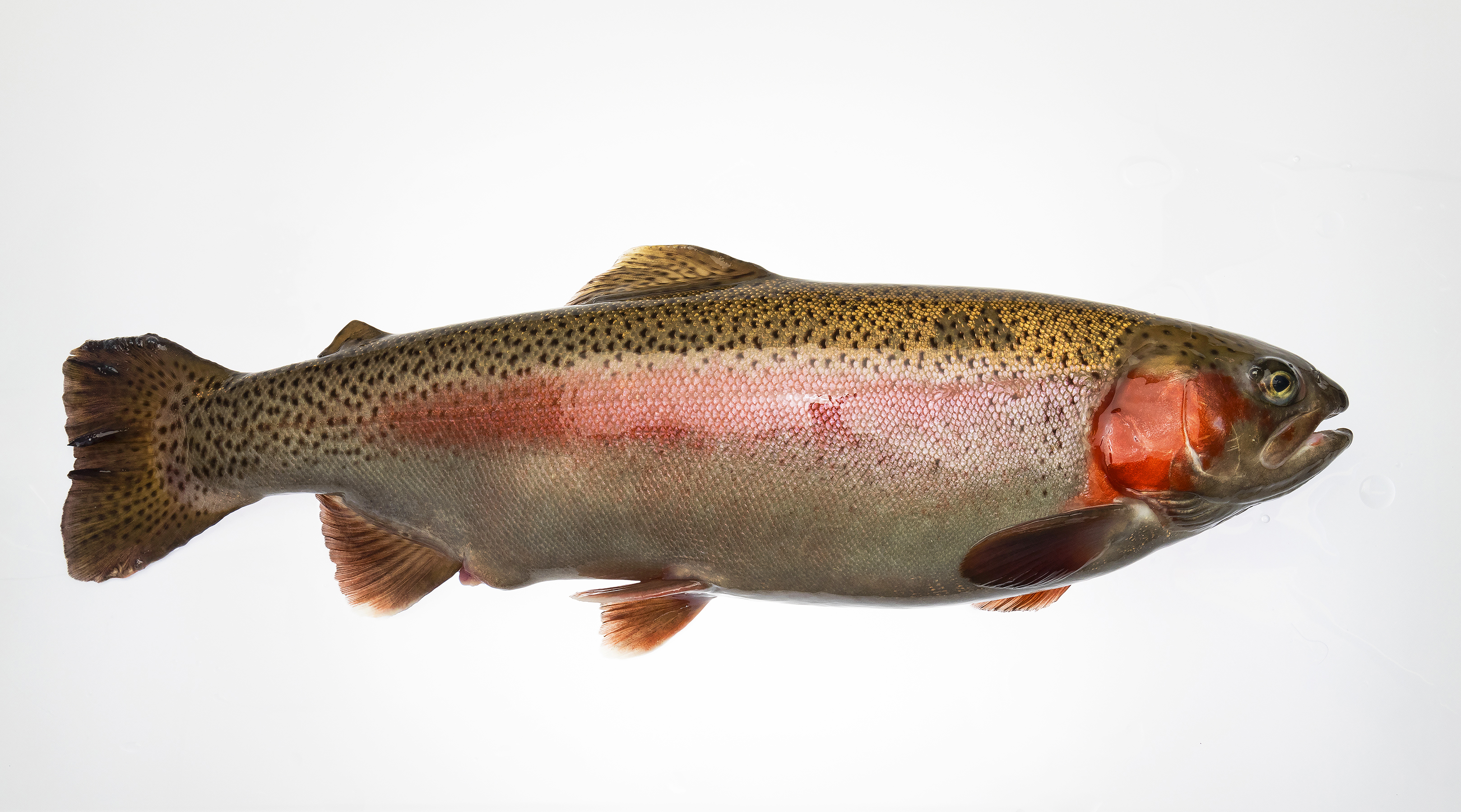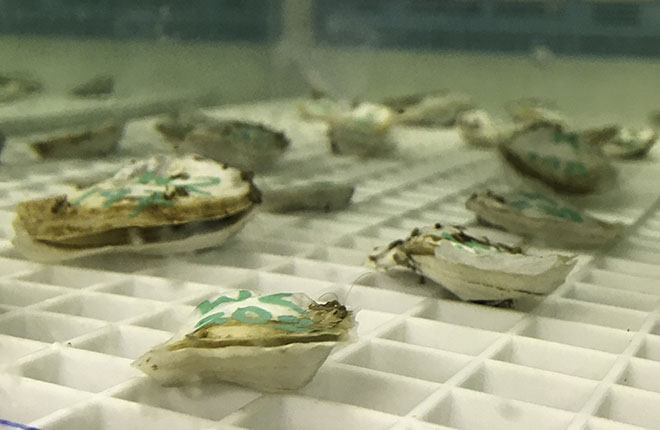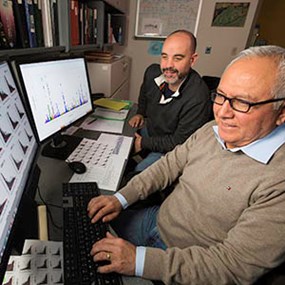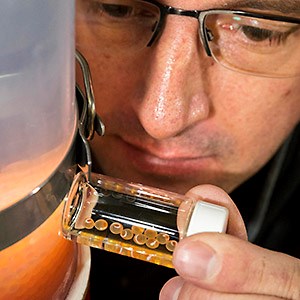Guarding Against Threats to Fish Health
Disease is a major problem for the aquaculture industry. Bacterial and parasitic outbreaks cause substantial economic losses in catfish, tilapia, trout, shellfish, and other aquatic animals due to medication costs, reduced fish growth, and death.
In recent years, Agricultural Research Service (ARS) scientists have made substantial gains in improving fish health. The scientists have examined nutrition’s role in improving fish health and performance, pioneered studies using genetics and selective breeding approaches to develop disease-resistant fish, and produced vaccines that target deadly diseases. Some of their recent research includes developing vaccines for emerging diseases, exploring the mechanisms of the immune system, and combating parasites that attack fish and shellfish.
Key Bacterial Players in Columnaris Disease
Columnaris disease impacts almost all U.S. finfish aquaculture industries. Caused by the bacterium Flavobacterium columnare, columnaris disease affects catfish, rainbow trout, tilapia, sport fish, bait fish, and ornamental fish and costs the fish-farming industry $40 to $50 million annually.
A 2015 survey of the Alabama catfish industry alone showed losses of about 1.5 million pounds of fish to this disease, despite use of medication and vaccines.
|
|
“Our recent research suggests if you’re going to make a successful vaccine, you must first consider the genetic background of the bacteria most commonly targeting your species of interest,” says Benjamin Beck, research leader of the ARS Aquatic Animal Health Research Unit (AAHRU) in Auburn, Alabama.
Previous research showed a large degree of genetic diversity among F. columnare strains recovered from fish with columnaris disease. Until now, little has been done to quantify or characterize this diversity in a systematic fashion. Research by AAHRU molecular biologist Benjamin LaFrentz and colleagues discovered four distinct genetic groups of F. columnare bacteria. Some genetic groups showed a preference for specific fish species.
“The difficulty in preventing and controlling columnaris disease in the past may reflect an inadequate understanding of this genetic diversity,” says LaFrentz.
LaFrentz and his team are analyzing strains from various U.S. diagnostic laboratories to better understand which genetic groups are most prevalent in different regions and aquaculture industries. Armed with this information, they can determine which genetic groups of F. columnare commonly attack catfish and which target trout or other species. This knowledge will allow for development of improved fish health management strategies, such as vaccines tailored for a specific fish species or region.
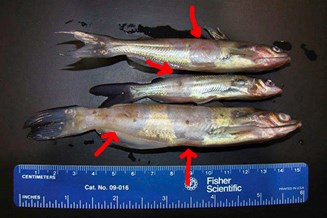 Columnaris disease lesions (arrows) on channel catfish. (Miles Lange, D3914-1) |
An Immune Response to Columnaris
At ARS’s Harry K. Dupree Stuttgart National Aquaculture Research Center in Stuttgart, Arkansas, scientists are investigating control and prevention methods specifically to protect catfish against columnaris disease.
In one study, published in Fish & Shellfish Immunology in 2016, microbiologist Miles Lange and his colleagues vaccinated channel catfish with an attenuated (weakened) wild type F. columnare strain. The vaccine did not protect the fish from a virulent F. columnare laboratory challenge. But the team found that individual channel catfish had all generated antibodies against F. columnare. Scientists went on to show that most of these antibodies had been made against a specific bacterial protein—DNAk. They are currently testing this individual protein as an antigen for a vaccine.
|
|
Lange and his colleagues continue to seek out other protein targets for use in vaccines, which has led to recent work on the formation of F. columnare biofilms on host-fish tissue. In research published in the Journal of Fish Diseases in 2017, Lange found that F. columnare will form very robust in vitro biofilms when stimulated with certain sugars. He later confirmed that biofilm formation is a virulence factor and is a significant part of columnaris infection. Lange and his colleagues are now looking at proteins required for biofilm formation as potential targets for vaccines.
Investigating a New Disease
A new type of Aeromonas hydrophila bacterium, first reported in 2009, has been devastating the catfish industry to the tune of $10 million per year in fish losses and treatment costs. Despite the bacterium’s virulence on farms, researchers nationwide could not produce the disease—motile aeromonas septicemia (MAS)—in laboratories, which delayed progress on developing prevention and control strategies.
Since then, AAHRU scientist Dunhua Zhang developed a reliable and reproducible method for inducing MAS in the laboratory. This model, published in FEMS Microbiology Letters in 2016, is needed for studying the disease and evaluating vaccines and treatments, Beck says.
“The ability to induce MAS allowed for studies that set the stage for vaccine development, which is currently under way with various industry partners,” Beck says. “We have identified some highly effective vaccine candidates that are being fast-tracked to help the industry with this debilitating disease.”
AAHRU investigators recently used the model to determine bacterial and host factors that govern the disease process. “We’ve learned that fish feeding is tightly linked to this disease,” Beck says. A study, published in Aquaculture in 2017, showed that recently fed fish were more susceptible to Aeromonas infections, supporting what is seen on catfish farms.
“It’s both the level of fullness and the frequency of feeding, so if they encounter this bacterium soon after feeding aggressively, it’s game over,” Beck says.
Scientists also found that the virulence of Aeromonas is linked to iron, an important element in disease mechanisms of most pathogenic bacteria. The bacteria obtain iron from the environment or the host. In a study published in Aquaculture in 2017, researchers added an iron-binding molecule to cultures of Aeromonas. The molecule, originally derived from other bacteria, keeps the iron away from Aeromonas. In laboratory infection trials, Aeromonas cultures treated with the molecule were twice as lethal as untreated Aeromonas. It appears that Aeromonas can detect the presence of limited iron, which ignites its ability to cause disease in catfish, Beck says.
“Competition for iron in production ponds may be driving Aeromonas to ramp up its iron uptake machinery to more efficiently acquire iron from the catfish host, ultimately resulting in rapid death.”
Taking On a Nasty Parasite
Ich, short for Ichthyophthirius multifiliis, is a nasty parasite that kills various freshwater fishes worldwide, resulting in severe losses to both food and ornamental fish.
The life cycle of Ich includes three stages: an infective free-swimming stage called a theront, a parasitic adult stage, and a reproductive adult stage. Treatments are available, but it is difficult to control the parasite using chemicals after its adult stage penetrates into fish skin and gills.
AAHRU parasitologist Dehai Xu developed a vaccine against this parasite. He found that healthy fish vaccinated against Ich with live infective theronts are protected against subsequent infection. He and collaborators determined the immune responses that may be responsible for protection against the parasite.
In his research, published in Fish and Shellfish Immunology in 2016, the fish surviving natural infections or immunized with live theronts—the free swimming stage of Ich—developed strong immune responses. Immunized fish showed significantly higher anti-Ich antibodies than control fish.
|
|
Stopping an Emerging Disease in Trout
In 2011, two commercial trout farms in North Carolina experienced heavy fish losses due to a fast-spreading trout pathogen. Timothy Welch, a microbiologist at ARS’s National Center for Cool and Cold Water Aquaculture (NCCCWA) in Leetown, West Virginia, led a major effort of stakeholders, Extension personnel, and pharmaceutical company representatives to contain the disease’s spread.
Using media and culture techniques uncommon in aquatic animal health diagnostics, Welch identified the disease pathogen as Weissella ceti. This bacterium had previously caused severe outbreaks in farmed rainbow trout in China and Brazil.
“This was the first time weissellosis disease had been identified in the United States,” Welch says. “The disease posed a significant threat to the aquaculture industry on the east coast.”
Quick identification allowed scientists to rapidly implement a control strategy to limit the spread and potentially eradicate the disease before it became an industry-wide problem.
Welch developed and validated a highly effective vaccine to control the disease and prevent fish loss. In addition, he and his team showed that the vaccine could be effectively delivered by injection techniques currently in use by the trout industry. The new vaccine is commercially produced by a vaccine manufacturer.
“Within a year of pathogen discovery, trout farms were using the commercial vaccine,” Welch says. “Since farmers started using the vaccine in 2012, the pathogen has not been detected in the United States.”
|
|
Breeding for Disease-Resistant Fish
By 2013, NCCCWA scientists had developed a new rainbow trout line, called ARS-Fp-R, that is resistant to bacterial cold water disease (BCWD). The disease affects trout, salmon, and other cold water fish and causes considerable economic loss to the aquaculture industry each year.
The new line has been transferred to industry and is being propagated by a commercial breeding company that wants to increase BCWD resistance in its rainbow trout lines.
Development of the resistant line took 10 years of selection using traditional pedigree-based methods, so NCCCWA scientists partnered with the company to evaluate genomic selection to make faster progress. “Genomic selection is a powerful approach that has been shown in livestock breeding to be more accurate than traditional selection,” says geneticist Yniv Palti.
In research published in BioMed Central in 2017, NCCCWA scientists showed that genomics is much more accurate than conventional breeding methods in predicting the genetic potential for BCWD resistance in the offspring of fish used for breeding.
“With the genomics-based method, we found a positive correlation of about 70 percent between the predicted genetic potential of the parents and the disease resistance of their offspring,” says Roger Vallejo, a statistical geneticist. “In comparison, the correlation for the same fish with the conventional method was about 35 percent.”
|
|
The research was done in collaboration with geneticists Kyle Martin and James Parsons from the Troutlodge, Inc., breeding company. In addition to Vallejo and Palti, the NCCCWA team included geneticist Timothy Leeds, microbiologist Jason Evenhuis, molecular biologist Gregory Wiens, and computational biologist Guangtu Gao.
According to the scientists, genomic selection will reduce the time, labor, and cost currently needed to improve disease resistance in commercial rainbow trout populations. This will have positive impacts on farm productivity and animal welfare, and reducing disease outbreaks will reduce the use of antibiotics in rainbow trout farming.
Tackling an Oyster Parasite
Oyster populations from the Gulf of Mexico to southern Maine are under siege from a dreadful parasite, Perkinsus marinus, which causes a disease called Dermo and kills more than 50 percent of the oysters it infects.
At ARS’s National Cold Water Marine Aquaculture Center, in Orono, Maine, scientists are partnering with the Aquaculture Genetics and Breeding Technology Center at the Virginia Institute of Marine Science to target disease resistance in shellfish, including oysters.
|
|
“Aquaculture growers lose so much of their product to disease, particularly Dermo,” says ARS geneticist Dina Proestou, who is stationed in Kingston, Rhode Island. “We’re trying to figure out what it means for an oyster to be disease resistant. Our work aims to enhance breeding for disease resistance by identifying potential phenotypic (physical) and genetic traits.”
Proestou and her team are looking at how oysters interact with P. marinus. Can oysters prevent parasite entry? And if the parasite does get in, are there immune mechanisms to eliminate or neutralize its effect?
Scientists use multiple oyster families (offspring produced from a single male and female mating) in their experiments.
“Families are important because each one has a unique genotype—a genetic background,” Proestou says. “We’ve found that not every family deals with the parasite in the same way.”
In a study submitted to the journal Marine Ecology Progress Series, Proestou found that when the parasite is present, feeding behavior changes for some—but not all—oysters. Resistant families respond to the presence of the waterborne parasite by increasing the rate of shell closure, while families susceptible to infection were less likely to modify their feeding behavior when this parasite was present, if at all.
“If we know certain genetic backgrounds can avoid the parasite by reducing the amount they feed when the parasite is present, we can select for that trait.”
Proestou and her team also looked at how oysters interact with the parasite once it gets into the shell. Parasites were injected into oyster shells of six different families. Survival varied with genetic background, as did the change in the number of parasites over time.
In the most susceptible family, many oysters died and few parasites were eliminated. The most resistant family experienced only one death out of 55 oysters and parasite numbers decreased significantly.
“Resistant oysters clearly deal with the parasite more effectively,” Proestou says.
The researchers also analyzed family-specific genes that turn on in response to parasite exposure. “A lot more genes are responding to the parasite in the resistant group, which is able to sense this parasite and mount an attack on it,” Proestou says. “But the susceptible group has fewer genes that are turned on in response, so their attack on the parasite is very weak.”
Other ARS research has resulted in improved fish feeds, dietary additives, and strategies to help reduce dependence on costly animal protein as well as antibiotics. ARS scientists continue to work with aquaculture farmers and industry partners to produce fish and shellfish that are healthier and more disease resistant.—By Sandra Avant, ARS Office of Communications.
Key Facts
- Columnaris disease costs fish farmers $40-$50 million in losses annually.
- Emerging pathogens cause additional economic losses to the aquaculture industry.
- ARS develops disease-resistant fish, vaccines, and control methods for healthier fish.
Full Story







